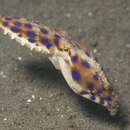Habitat
provided by EOL authors
The blue ringed octopus can be found living in small tide pools and shallow reefs in the Pacific Ocean, mostly covering land from Japan to Australia (1). It usually lives at depths ranging from 0-20 meters. (3)
Reproduction
provided by EOL authors
The reproduction habits of the blue ringed octopus include the practice of internal fertilization. After enticing his mate with displays of body expansion and color change, the male octopus will crawl onto the female’s back, covering everything except her tentacles. (1) Then the male will inject a small amount of sperm into the female’s oviduct from its storage space in the grooved tip of the male’s third arm, where the sperm forms eggs. The female lays and protects her eggs. The female octopus usually lay somewhere around 50-100 eggs and once the eggs hatch the mother octopus dies of starvation. (4) Another unique and interesting thing about octopus reproduction is the octopus’ release of chemical stimulants and hormones into the water when mating. These chemicals, along with the changes in color of the octopus during mating rituals appear to be a means of communication between mates. (2)
Venom
provided by EOL authors
Although the blue ringed octopus appears extremely docile and calm, it is actually one of the most dangerous creatures in the ocean. This octopus produces a venomous neurotoxin that contains tetrodotoxin, 5-hydroxytryptamine, hyaluronidase, tyramine, histamine, tryptamine,octopamine, taurine, acetylcholine, and dopamine. (1) Although the octopus is small, its venom is powerful enough to kill a human. The toxin kills by causing motor paralysis, which leads to respiratory arrest, and then cardiac arrest due to lack of oxygen. Bacteria in the octopus’s salivary glands create the toxin, which is delivered through small, often painless bites. (5) At any given time a blue-ringed octopus may be carrying enough venom to kill 26 full-grown humans within minutes. There is no known antidote to a bite by a blue ringed octopus. (3)

